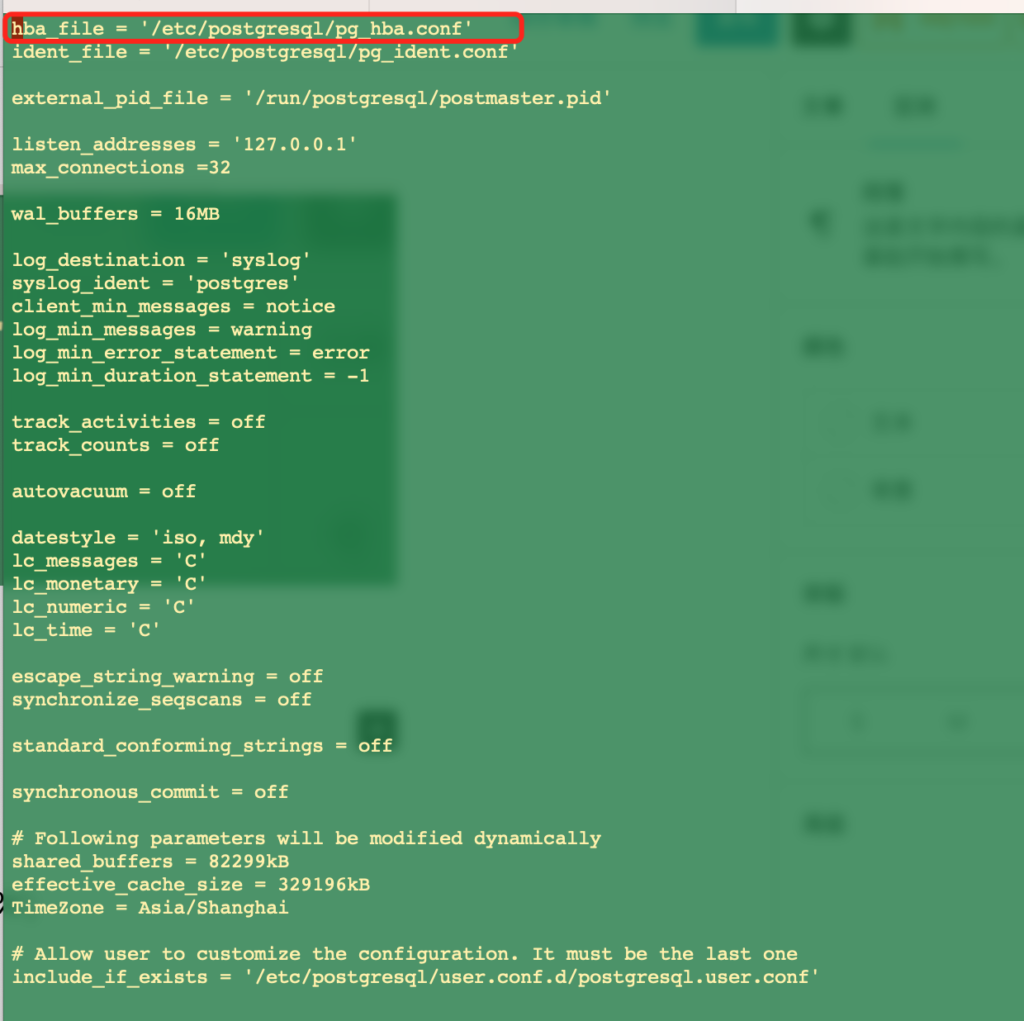查询配置文件
登录服务器查询sql进程 ps -ax | grep sql 如下图所示

查看数据库目录 找到数据库配置文件

打开配置文件 查看配置

hba_file = '/etc/postgresql/pg_hba.conf' 就是验证配置文件
listen_addresses = '127.0.0.1' 是数据库绑定的地址,如果需要外网访问 则需要修改成 0.0.0.0
修改了监听地址的话 需要重启数据库
还可以通过如下命令直接查到配置文件
连接服务器 使用 sudo -u postgres psql 直接无密码进入查询命令行
查询验证的配置文件位置 select * from pg_settings where name like '%hba%';

修改hba_file
官方原始文件如下,原始文件中解释了每个字段的含义以及用途
# PostgreSQL Client Authentication Configuration File # =================================================== # # Refer to the "Client Authentication" section in the PostgreSQL # documentation for a complete description of this file. A short # synopsis follows. # # This file controls: which hosts are allowed to connect, how clients # are authenticated, which PostgreSQL user names they can use, which # databases they can access. Records take one of these forms: # # local DATABASE USER METHOD [OPTIONS] # host DATABASE USER ADDRESS METHOD [OPTIONS] # hostssl DATABASE USER ADDRESS METHOD [OPTIONS] # hostnossl DATABASE USER ADDRESS METHOD [OPTIONS] # # (The uppercase items must be replaced by actual values.) # # The first field is the connection type: "local" is a Unix-domain # socket, "host" is either a plain or SSL-encrypted TCP/IP socket, # "hostssl" is an SSL-encrypted TCP/IP socket, and "hostnossl" is a # plain TCP/IP socket. # # DATABASE can be "all", "sameuser", "samerole", "replication", a # database name, or a comma-separated list thereof. The "all" # keyword does not match "replication". Access to replication # must be enabled in a separate record (see example below). # # USER can be "all", a user name, a group name prefixed with "+", or a # comma-separated list thereof. In both the DATABASE and USER fields # you can also write a file name prefixed with "@" to include names # from a separate file. # # ADDRESS specifies the set of hosts the record matches. It can be a # host name, or it is made up of an IP address and a CIDR mask that is # an integer (between 0 and 32 (IPv4) or 128 (IPv6) inclusive) that # specifies the number of significant bits in the mask. A host name # that starts with a dot (.) matches a suffix of the actual host name. # Alternatively, you can write an IP address and netmask in separate # columns to specify the set of hosts. Instead of a CIDR-address, you # can write "samehost" to match any of the server's own IP addresses, # or "samenet" to match any address in any subnet that the server is # directly connected to. # # METHOD can be "trust", "reject", "md5", "password", "gss", "sspi", # "krb5", "ident", "peer", "pam", "ldap", "radius" or "cert". Note that # "password" sends passwords in clear text; "md5" is preferred since # it sends encrypted passwords. # # OPTIONS are a set of options for the authentication in the format # NAME=VALUE. The available options depend on the different # authentication methods -- refer to the "Client Authentication" # section in the documentation for a list of which options are # available for which authentication methods. # # Database and user names containing spaces, commas, quotes and other # special characters must be quoted. Quoting one of the keywords # "all", "sameuser", "samerole" or "replication" makes the name lose # its special character, and just match a database or username with # that name. # # This file is read on server startup and when the postmaster receives # a SIGHUP signal. If you edit the file on a running system, you have # to SIGHUP the postmaster for the changes to take effect. You can # use "pg_ctl reload" to do that. # Put your actual configuration here # ---------------------------------- # # If you want to allow non-local connections, you need to add more # "host" records. In that case you will also need to make PostgreSQL # listen on a non-local interface via the listen_addresses # configuration parameter, or via the -i or -h command line switches. # CAUTION: Configuring the system for local "trust" authentication # allows any local user to connect as any PostgreSQL user, including # the database superuser. If you do not trust all your local users, # use another authentication method. # TYPE DATABASE USER ADDRESS METHOD # "local" is for Unix domain socket connections only local all all trust # IPv4 local connections: host all all 127.0.0.1/32 trust # 在这里添加一行 # 远程访问类型 可以访问所有数据库 任意用户可以登录 登录的ip地址 跳过密码验证 host all all [你的ip地址]/32 trust # 就上面这一行 # IPv6 local connections: host all all ::1/128 trust # Allow replication connections from localhost, by a user with the # replication privilege. #local replication postgres trust #host replication postgres 127.0.0.1/32 trust #host replication postgres ::1/128 trust
最后刷新hba配置文件
sudo -u postgres pg_ctl reload -D /var/services/pgsql
-D 后面的目录就是 通过 ps -ax | grep sql 查找的那个sql的目录